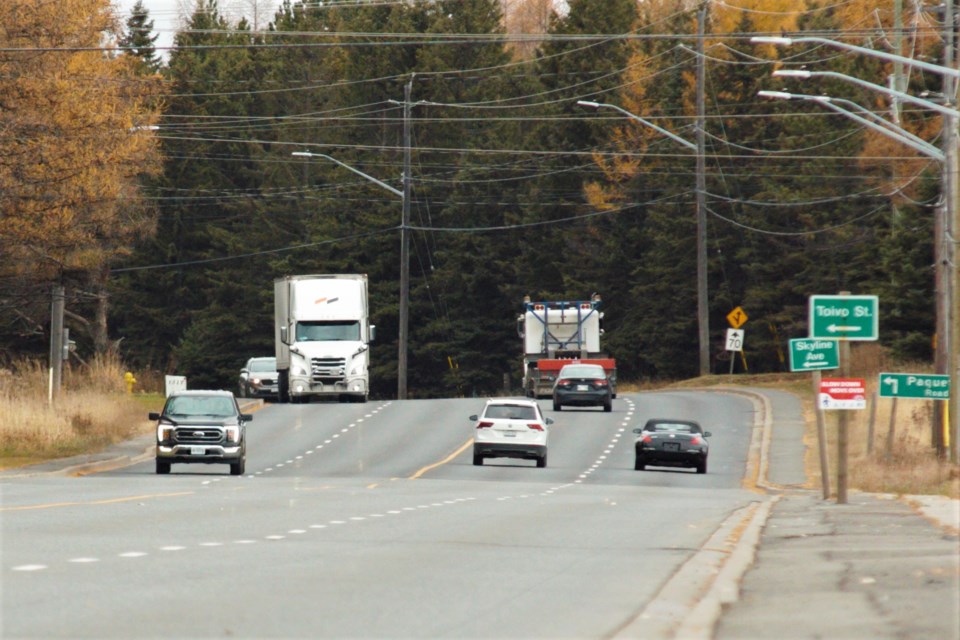THUNDER BAY — After years of debate, false starts, and reversals, Coun. Albert Aiello is hopeful the designated truck route he’s helped champion could soon become a reality.
The newly-elected city council that will take office on Nov. 15 will bring fresh eyes to the issue in 2023, after it gridlocked the current council, which was unable to find a way forward despite years of debate.
The McIntyre ward councillor expressed cautious optimism the new council, with six of its 13 members newly elected, could tip the balance. The most recent vote to implement the designated truck route failed in 2020 on a 7-6 vote.
“They are aware that this is going to be a topic that will be brought forward again, and hopefully we can get it resolved,” he said of the new council. “New people are around the table, different ideas.”
City administration continues to recommend implementing the designated truck route, which would force heavy truck traffic off of Dawson Road and Arthur Street, and onto Highway 11/17 and the Harbour Expressway extension, said Kayla Dixon, the city’s director of engineering and operations.
“Certainly we still do recommend that — it’s responsible traffic engineering to move heavy truck [traffic] to higher order roads,” she said. “It’s similar to [how] we don’t want delivery trucks and dump trucks cutting through residential streets — we don’t want truck traffic cutting through Dawson Road and Arthur when they have the option of the Trans-Canada Highway.”
City engineers concluded in a 2018 report that the truck route would bring safety benefits and address concerns from residents along Arthur and Dawson over safety, noise, and vibrations.
A collision analysis included in that report found “the predicted safety impacts [of implementing the DTR] would be in the order of fractions of a collision per year on a per intersection or per kilometre basis.”
Dixon said while the reduction in serious collisions might be minor, there are several good reasons to move forward with it.
“There’s not like a really hard line between whether it is safer to have those trucks on Dawson and Arthur or on Highway 11/17 through Thunder Bay,” she said. “We did see a fraction of collisions that would be [averted] by moving that traffic to the Harbour Extension. We’re not seeing double or triple or anything like that, but certainly we do expect a safety improvement.”
“The Harbour extension, as well as Highway 11/17 through the city, are designed for heavy trucks and higher speeds, they’ve got more space.”
Administration plans to present the bylaw rejected in 2020 again to the new council next year, sometime after the weeks-long process to set the 2023 budget in January and February, said Dixon.
The current council would have required a two-thirds majority vote to either enact or definitively reject a designated truck route, after tying itself into procedural knots over the course of several votes.
The new council will have a simpler path to a resolution, requiring a simple majority for a decision — one reason Aiello is hopeful a resolution can be reached.
He added that concerns over potential plans to transport nuclear waste to a deep geological repository in the Revell Lake area, near Ignace, only amplify the need for a designated truck route.
“With this new council, it’s front and centre — it’s not going away,” he said.
He also expects the incoming council could decide quickly on the truck route.
“To be honest, I really think all of the information has already been brought forward — there’s not going to be any new information,” he said.
Council has received at least three reports on the designated truck route, as well as a report on traffic safety on Dawson Road, from city staff in recent years.
“Certainly there are lots of reports that they could read, but we’re happy to provide an update if council gives us that direction,” said Dixon.
A 2022 report concluded the stretch of Dawson Road within city limits has had a collision rate lower than the average Ontario roadway over the past decade, but that heavy trucks play an outsize role in those that do occur.
Tractor trailers were involved in 28 per cent of collisions on Dawson in that time, despite making up under 15 per cent of traffic.
Those conclusions don’t change the need for a designated truck route, Dixon said, reiterating that moving trucks to “higher order” roads is better traffic planning and that a traffic analysis had indicated the truck route would improve safety.
The city has worked in other ways to improve safety on Dawson Road, she noted, including speed limit reductions and the creation of a community safety zone with speed radar feedback signs near Five Mile School.
City council is also expected to receive a report in December on the potential of adding automated speed enforcement in the community safety zone.
The province has indicated it's reviewing potential improvements including signage, rumble strips, and lighting upgrades at Sistonen’s Corner, where highways 11/17 and 102 meet, and several fatal collisions have occurred in recent years.
